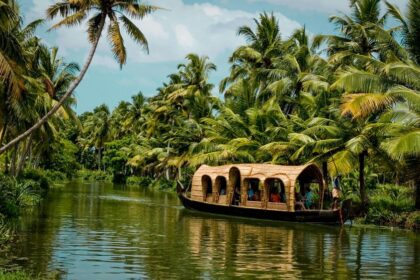India is home to one of the richest and most diverse ecosystems in the world. With its varied geography—from snow-covered mountains and dense tropical forests to arid deserts and mangrove swamps—the country hosts an incredible array of flora and fauna. Wildlife Sanctuaries & National Parks in India serve as vital refuges for these species, offering protection, conservation, and an unforgettable experience for travelers seeking nature and adventure.
Whether you’re looking to spot a Royal Bengal Tiger, photograph colorful birds, or simply unwind in the lap of nature, India’s Wildlife Sanctuaries & National Parks provide unique and thrilling opportunities.
Why Explore Wildlife Sanctuaries & National Parks?
- Biodiversity Hotspots: India has over 100 national parks and more than 500 wildlife sanctuaries, covering all major biodiversity zones.
- Endangered Species Protection: From the majestic tiger to the elusive snow leopard and the Indian rhinoceros, many sanctuaries are vital for the survival of rare species.
- Eco-Tourism: These protected areas promote sustainable travel while educating visitors on conservation.
- Photography and Adventure: Ideal for wildlife photographers, nature lovers, and adventure seekers.
Top Wildlife Sanctuaries & National Parks in India
1. Jim Corbett National Park, Uttarakhand
Established in 1936, it is India’s oldest national park and the first under Project Tiger. Home to Bengal tigers, elephants, leopards, and over 600 bird species, it’s a paradise for wildlife lovers.
2. Ranthambore National Park, Rajasthan
Known for its royal tigers and historic Ranthambore Fort, this park offers a mix of wildlife and heritage. The dry deciduous forest makes animal spotting relatively easier.
3. Kaziranga National Park, Assam
A UNESCO World Heritage Site, Kaziranga boasts the world’s largest population of the Indian one-horned rhinoceros. It also shelters elephants, swamp deer, wild buffalo, and tigers.
4. Sundarbans National Park, West Bengal
Famous for its mangrove forests and elusive Royal Bengal Tigers, the Sundarbans is also home to crocodiles, monitor lizards, and hundreds of bird species.
5. Gir Wildlife Sanctuary, Gujarat
The last remaining habitat of the Asiatic lion, Gir is also home to leopards, hyenas, antelopes, and marsh crocodiles.
6. Periyar Wildlife Sanctuary, Kerala
Located in the Western Ghats, this sanctuary is known for elephants and boat safaris on Periyar Lake. It’s a great spot for birdwatching and spice plantation tours as well.
7. Bandhavgarh National Park, Madhya Pradesh
This park has one of the highest tiger densities in India. It’s also rich in birdlife and has historical significance with ancient ruins and caves.
8. Kanha National Park, Madhya Pradesh
The inspiration for Rudyard Kipling’s The Jungle Book, Kanha features dense forests, grassy meadows, and is home to tigers, barasinghas, and leopards.
9. Nagarhole National Park, Karnataka
Part of the Nilgiri Biosphere Reserve, Nagarhole offers sightings of elephants, tigers, bison, and hundreds of bird species in a lush forest setting.
10. Hemis National Park, Ladakh
India’s highest altitude national park, it’s a haven for snow leopards. Ideal for high-altitude wildlife lovers and those seeking offbeat wilderness.
Unique Wildlife Experiences in India
- Jeep Safaris: Available in most major parks like Ranthambore, Corbett, and Bandhavgarh.
- Boat Safaris: In Periyar and Sundarbans, these offer a different perspective on wildlife.
- Walking Trails: Offered in smaller sanctuaries and eco-reserves like Wayanad and Satpura.
- Birdwatching Tours: Bharatpur Bird Sanctuary and Ranganathittu are major birding hotspots.
Importance of Wildlife Sanctuaries & National Parks
- Conservation: They help protect endangered species and their habitats.
- Scientific Research: These areas allow for ecological studies and biodiversity monitoring.
- Education: They spread awareness about the importance of protecting the environment.
- Economic Development: Promote eco-tourism and create jobs for local communities.
Best Time to Visit
- Winter (October to March): Ideal for most parks with pleasant weather and better visibility.
- Summer (April to June): Best time for tiger sightings as animals visit water bodies often.
- Monsoon (July to September): Many parks remain closed, but southern sanctuaries may still offer visits.
Responsible Wildlife Tourism Tips
- Book with Licensed Operators: Choose ethical tours that follow park rules.
- Don’t Disturb Animals: Keep silence, avoid feeding or attracting animals.
- Carry Binoculars & Cameras: For better observation without disturbing the habitat.
- Avoid Littering: Follow a strict “Leave No Trace” policy.
- Respect Local Communities: Their livelihoods often depend on eco-tourism.
Conclusion
India’s Wildlife Sanctuaries & National Parks offer a perfect blend of adventure, education, and natural beauty. Whether it’s the thrill of seeing a tiger in the wild, the serenity of bird calls at sunrise, or the joy of learning about forest ecosystems, these protected areas leave a lasting impression on every visitor.
India is home to one of the richest and most diverse ecosystems in the world. With its varied geography—from snow-covered mountains and dense tropical forests to arid deserts and mangrove swamps—the country hosts an incredible array of flora and fauna. Wildlife Sanctuaries & National Parks in India serve as vital refuges for these species, offering protection, conservation, and an unforgettable experience for travelers seeking nature and adventure.
In an age where natural habitats are under constant threat, visiting and supporting these sanctuaries is not just a travel choice — it’s a way to contribute to the planet’s future. So, pack your gear and immerse yourself in the wild wonders of India’s incredible biodiversity.






